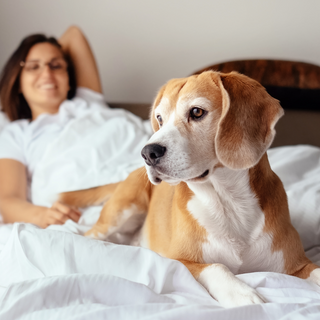Winter Fur Grooming Guide
by IPET Network
This winter, it's very likely that your dog will be sporting their magnificent natural winter coat. This is wonderful news for our pets as the extra fur helps to keep them warm and happy, but there are extra steps that we need to take to ensure that they stay healthy too. Long-haired dogs should be professionally groomed every 4-8 weeks, depending on their breed, coat type and the style you choose to have.
Here Sarah Mackay and Fern Gresty, dog grooming experts and founders of the iPET Network qualification provider, explain what you can do at home to keep your pet's winter coat in perfect condition.

Brushing is key:
Brushing has numerous benefits: it removes dead hair, distributes natural oils in your dog's coat, stimulates blood circulation, and it's a great way to bond with your dog too. Have a good quality 'slicker brush' and a metal comb.
Have a method:
When brushing, you should work through the coat methodically and cover the hard-to-reach areas; parting the hair into sections will ensure you get every area. The ears, beard, face, under the belly, in between the legs and tail are areas that tend to get knotty and tangled first. A good tip is to buy a detangler or coat conditioner spray. Spray this all over your dog before brushing, making it easier to brush through.
Laid-back pose:
Position your dog, so they are lying on one side. Divide the hair in a straight line from the shoulder to the tail. Work in sections. Using your slicker brush, be firm but gentle, and use long, slow strokes.If your dog is distracted whilst you brush them, give them their favourite toy or treat or ask someone to help you.

Distraction can be useful:
Licking mats are fantastic for distracting dogs; these are soft rubber mats that you can spread soft treats onto, such as a meaty paste or dog peanut butter. Licking also has an anti-anxiety effect on dogs.
Avoid irritation:
Ensure you don't go over the same area of hair multiple times with your slicker brush, as you may cause skin irritation. After one or two long strokes, if there are no knots, move on to the next section.
If you find a knot that is harder to remove, spray some detangler into the knot, and go over it with the slicker brush and comb to loosen it. To protect your dog's skin, you can use your finger as a guard behind the knot and your dog's skin whilst brushing.
Move onto metal comb:
Once you have used your slicker brush all over your dog, go over the coat with your metal comb. This combination should ensure to keep your dog's coat knot free and shiny. If you find knots you cannot remove, no matter how you try, contact your dog groomer, as they can help!
A raincoat will keep your dog dry and protect their coat from mud and rain in the winter.

Avoid matting when towel drying:
When drying your dog after returning from a wintery walk in the wind, rain or snow, ensure to towel dry the hair but squeeze the hair with the towel to avoid vigorous rubbing because this could cause matting/knots.
Remove any harnesses/collars/coats from your dog whilst in the house. Wearing these for long periods can cause friction and matting underneath them.
To find out more about the iPET Network, go to www.ipetnetwork.co.uk
Read more!
Loved these winter grooming tips? Head over to the Paws The Word blog to discover more expert articles on dog health, grooming, behaviour, and wellbeing.
- Choosing a selection results in a full page refresh.


